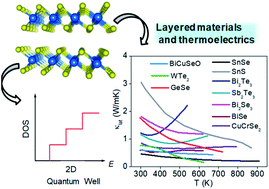Layered materials with 2D connectivity for thermoelectric energy conversion
Abstract
The current problems of decreasing fossil fuel reserves and the increasing pollution level due to burning of these fossil fuels are expected to worsen in the future with ever increasing global energy demand. Thermoelectric energy conversion, the conversion of waste heat into useful electrical energy, is one of the key ideas to mitigate some of the problems and build a sustainable future. In addition to the superior electronic and optoelectronic properties, to name a few, of layered materials that we have seen in this century, these materials show outstanding thermoelectric properties as well. Layered materials, such as Bi2Te3, SnSe and BiCuSeO, have truly revolutionized the thermoelectric research. Strong in-plane and weak out-of-plane bonding in layered materials cause bonding heterogeneity, and the consequent lattice anharmonicity brings down the lattice thermal conductivity. Furthermore, the presence of atomically thin layers with weak interlayer interactions results in many low-dimensional features in electronic transport, such as the quantum confinement of free charge carriers leading to an enhanced Seebeck coefficient. While this congruence of lattice anharmonicity and low-dimensional electronic features makes these layered materials ideal for achieving high thermoelectric performance, their anisotropic electronic and phonon transport properties provide important fundamental insights as well. In this review, we aim to provide an in-depth insight into the structure–property relationship, with a focus on the electronic and phonon transport properties, of various state-of-the-art layered thermoelectric materials. We will discuss novel strategies that have been developed to mitigate the various challenges associated with the optimization of the thermoelectric properties of these layered materials. We will demonstrate the recent progress and present an outlook which can be regarded as a guiding tool to realize new high-performance thermoelectric materials as well as their potential application scenarios.



 Please wait while we load your content...
Please wait while we load your content...